
Poetic moments
Text & pics: Ranjana Dave
e-mail: ranjana.dave@gmail.com
December 25,
2008
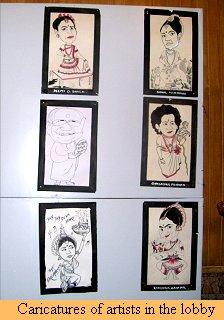 It
is 6pm. The sun has disappeared a long time ago. Jayadeva Utsav at Habitat
World is still a few traffic jams away. I never appreciated Mumbai's sardine
tin local trains till I met Delhi's extortionist auto-rickshaw drivers.
And its reputation as an unsafe city doesn’t make one feel any better. It
is 6pm. The sun has disappeared a long time ago. Jayadeva Utsav at Habitat
World is still a few traffic jams away. I never appreciated Mumbai's sardine
tin local trains till I met Delhi's extortionist auto-rickshaw drivers.
And its reputation as an unsafe city doesn’t make one feel any better.
When I reached
Stein Auditorium around 6.35 pm, what caught my eye was – people, early,
waiting to be allowed in. Correct me if I’m mistaken, but I have never
seen people queue up early in Mumbai for dance events, even though traveling
is a lot easier. When the ushers let us in, the second thing that struck
me as unique was the corner where two full boards of artist caricatures
stared me in the face. They were nice to some people and took naughty potshots
at others. Probably I'm only over-reacting to the delights Delhi has to
offer, but well, Shilpi Ashok has really done a great job there! Sadly,
one of the two boards had been removed the next day, when I went to take
a photograph of them.
Presented by
Odissi Akademi under the guidance of Kavita Dwivedi, Jayadeva Utsav was
held over two days, November 3-4, 2008. Now in its sixth year, the festival
instituted the Jayadeva Samman award this time. A mark of respect to the
epic poet, it was conferred on Raghunath Panigrahi for his immense contribution
to Odissi music. It comprised of a cash prize, a citation and a plaque.
A national seminar accompanied the festival, where papers on the many functions
and roles of the Gitagovinda were presented. Some papers were also published
in the festival souvenir.
The first evening
began with the presence of politicians and other equally distinguished
people who waxed eloquent about Jayadeva. But theory turned into practice
when Raghunath Panigrahi re-inaugurated the proceedings with his singing.
Clad in a startling yellow-green kurta, his slight stature belied the powerful
voice that lay within. His son Partharasarathi Panigrahi also took to the
stage for one piece.
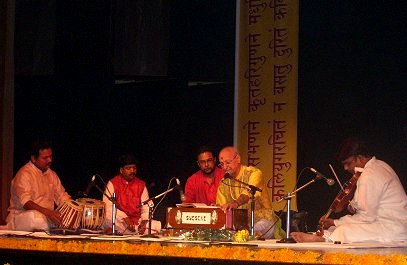 Raghunath Panigrahi
Raghunath Panigrahi
|
 Gopika Varma
Gopika Varma
|
Full of secret
smiles, Mohiniattam dancer Gopika Varma began the dance segment of the
Utsav with the well-loved Chandana charchita, continuing with the
equally popular Dheere Sameere. Her white and gold costume was given
just a hint of colour by the red blouse; her soft and deep movements were
offset by the pulsating edakka in a similar manner. She charmed with expressive
eyes that did much of the talking.
Prathibha Prahlad
came next with three pieces. Mugdhe madhumathanam was full of verve,
complemented by the shocking pink costume. She also danced to Pasyati
disi disi and Kuru yadu nandana. Vocalist P Rama had a voice
that was well-grounded and soothing in an earthy manner.
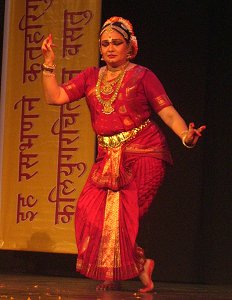 Pratibha Prahlad
Pratibha Prahlad
|
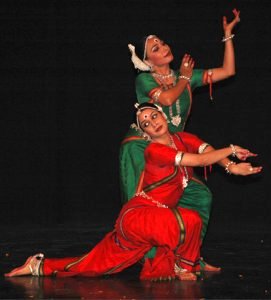 Nrityagram - Surupa Sen and Bijayini Satpathy
(file photo)
Nrityagram - Surupa Sen and Bijayini Satpathy
(file photo)
|
Today, when the
Gitagovinda has been extensively choreographed, interpreted and reinterpreted,
the need of the hour is a re-exploration of choreography to find interpretations
that are not just representative of a long gone past, but are ones that
are imbued with a sense of immediacy. Nrityagram's Dheere Sameere
could have been the story of any two love-struck girls. Dressed in flamboyant
green, Bijayini Satpathy with her infectious smile was a compelling juxtaposition
to Surupa Sen's understated mischief and poise. They were constantly picture-perfect
– each moment was carefully chalked out and executed. Sen and Satpathy
ended the first day’s proceedings with a short Kisalaya shayana,
where the lighting played an important role in setting the mood of the
piece.
The second
day literally started on a 'different note,' with Pt. LK Pandit of the
Gwalior gharana rendering some ashtapadis in the khayal style.
This style of ashtapadi singing was the brainchild of Pt. Visnu
Pandit, a Sanskrit scholar of the early 19th century. With the help of
two Gwalior gharana musicians of his time, these ashtapadis began
to be sung as kirtans.
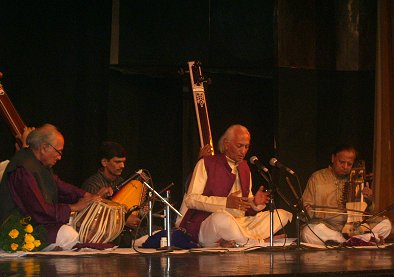 L K Pandit
L K Pandit
|
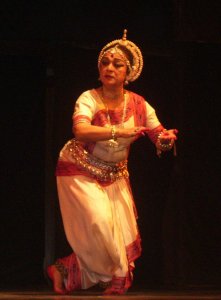 Kiran Segal
Kiran Segal
|
Attired in white
and red, Kiran Segal was the second Odissi dancer to perform at the event.
She chose to present Nindati chandanam and Yahi Madhava.
While her abhinaya had some compelling moments, occasionally, she seemed
disoriented. Kuchipudi dancer Sailaja went next. Her long plait swinging
from side to side, she was extremely enthusiastic - Radhika tava virahe
Keshava was full of energetic movement – leaps, claps, the works; though
it was a tad overdone at times.
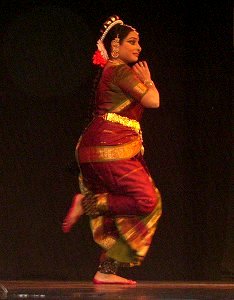 Sailaja
Sailaja
|
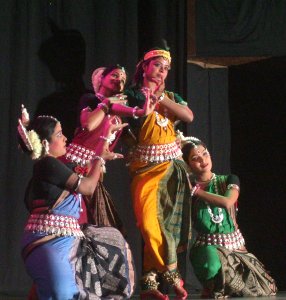 Srjan
Srjan
|
Ratikant Mohapatra
put together a slickly edited segment for his troupe from Srjan. Six dancers
– Rajashri Praharaj, Manosmita Panda, Rachana Rimjhim, Swagatika Sahani,
Swagatika Mohapatra and Rajnita Banerjee - began with Vedanu dharate,
the Dasavatara in a tiny capsule. Breaking the Gitagovinda pattern of the
event, Panda and Praharaj then presented Megh Pallavi. This continued with
a story woven out of three ashtapadis – Lalita lavanga, Rase harim iha
and Radha vadana, that depicted a philandering Krishna’s slow
but sure return to his lover Radha. Colour played a prominent role – from
sheer blue to bright yellow, they were all there. The dancers enjoyed themselves,
while making a competent presentation. Jayadev Das added depth with clever
lighting, using prominent overtones of green and blue. The music was interestingly
arranged; but the acoustics were somewhat overwhelming in parts - the female
vocal track was too shrill to be heard comfortably at times.
In Mumbai,
there may be a fairly vexing 10pm ban on loudspeakers. But the trains run
until much later! The first day of the Utsav, I was stranded without a
ride home...not a very nice feeling. Finding one was so tiring, I almost
decided not to come back for the second day. I'm thankful I did, since
Jayadeva Utsav was a very intriguing experience. It will be even more interesting
to see what direction the festival takes in its trajectory of evolution. |

